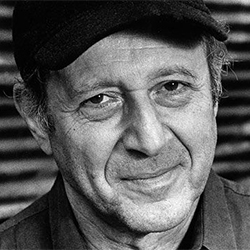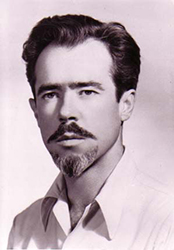 Back in October, i marked George Crumb’s birthday exploring a performance of his seminal work Black Angels, given by The Smith Quartet. That performance was part of a concert devoted to American music, and it makes sense to explore the remaining pieces. The concert, which took place at the Cheltenham Music Festival on 11 July 2001, opened with the UK première of Steve Reich‘s Triple Quartet. Even relatively blunt-eyed readers of 5:4 may have noticed the paucity of discussion about minimalism on these pages, and that’s no accident; it’s a generalisation, to be sure, and there are many exceptions, but for the most part minimalism leaves me very cold indeed. Yet despite his more recent compositional catastrophes—the less said about WTC 9/11 the better—Reich’s kind of minimalism impresses more than most.
Back in October, i marked George Crumb’s birthday exploring a performance of his seminal work Black Angels, given by The Smith Quartet. That performance was part of a concert devoted to American music, and it makes sense to explore the remaining pieces. The concert, which took place at the Cheltenham Music Festival on 11 July 2001, opened with the UK première of Steve Reich‘s Triple Quartet. Even relatively blunt-eyed readers of 5:4 may have noticed the paucity of discussion about minimalism on these pages, and that’s no accident; it’s a generalisation, to be sure, and there are many exceptions, but for the most part minimalism leaves me very cold indeed. Yet despite his more recent compositional catastrophes—the less said about WTC 9/11 the better—Reich’s kind of minimalism impresses more than most.
His Triple Quartet is so named for the way two prerecorded string quartets are superposed upon a live quartet (alternatively, it can be performed by 12 live musicians). The triple idea extends to the work’s structure, being in three movements that adhere to the age-old convention fast-slow-fast. The outer movements are essentially the same idea explored in a slightly different way; a harmonic progression of four minor chords (Bm, Dm, Fm and G?m — Reich calls them “dominant” chords but without conventional tonality that term is meaningless) that underpin rapid rhythmic material. In the first movement, there’s much overlapping of these chords, but the changes become increasingly abrupt, and by the last movement, driven on by the rhythmic writing, these chords fly past very quickly indeed. The slow central movement is much more static, both rhythmically and harmonically, focused on and around the B minor chord alone. Both of the faster movements feature material of a more lyrical nature, with a kind of folk-like plangency, and this comes to the fore in the middle movement, made both more poignant and potent by the abrupt halt in the tempo and the stronger sense of counterpoint. This is what makes the Triple Quartet worth hearing; despite the intensity of this slow episode making the outer movements seem even more ephemeral and arbitrary—a kind of empty energy—the music’s sudden switch to oscillations around a fixed point is rather mesmerising. But make no mistake, the slow movement is most definitely the meat in this sandwich.
 The second half of the concert began by turning to one of America’s great mavericks, Conlon Nancarrow. Best known for his radical series of studies for the player-piano, Nancarrow’s String Quartet, completed in 1945, draws on similar techniques to those pieces, despite inhabiting a markedly different soundworld. Also cast in three movements, the first—a mere 2½ minutes long—is almost entirely made up of a mixture of canonic and isorhythmic devices; the harmony is akin to the kind of oblique tonality of Bartók, while the rhythmic writing occasionally brings Tippett to mind. These frantic textures find a total contrast in the second movement (Andante moderato); it’s no less canonic (if anything, it’s more), but the music is lazy and languid, coloured by vague allusions to the blues. It, too, is gone almost as soon as it’s got going, and Nancarrow concludes the piece with another movement absolutely festooned with contrapuntal invention, including double and inversion canons, climaxing with a rather fantastical 8-part canon, two voices given to each instrument. Aside from maths, though, this finale is most striking through the diversity of methods by which the material is expressed, with pizzicato and harmonic passages nicely juxtaposed amongst dense counterpoint.
The second half of the concert began by turning to one of America’s great mavericks, Conlon Nancarrow. Best known for his radical series of studies for the player-piano, Nancarrow’s String Quartet, completed in 1945, draws on similar techniques to those pieces, despite inhabiting a markedly different soundworld. Also cast in three movements, the first—a mere 2½ minutes long—is almost entirely made up of a mixture of canonic and isorhythmic devices; the harmony is akin to the kind of oblique tonality of Bartók, while the rhythmic writing occasionally brings Tippett to mind. These frantic textures find a total contrast in the second movement (Andante moderato); it’s no less canonic (if anything, it’s more), but the music is lazy and languid, coloured by vague allusions to the blues. It, too, is gone almost as soon as it’s got going, and Nancarrow concludes the piece with another movement absolutely festooned with contrapuntal invention, including double and inversion canons, climaxing with a rather fantastical 8-part canon, two voices given to each instrument. Aside from maths, though, this finale is most striking through the diversity of methods by which the material is expressed, with pizzicato and harmonic passages nicely juxtaposed amongst dense counterpoint.
The Smith Quartet ended their concert with one of Steve Reich’s most justly-celebrated works, Different Trains. Composed in 1988, the work is in essence a culmination of the various ideas and techniques Reich had been using since his very earliest compositions. Prior to this piece, Reich had composed three works exploring the contrapuntal possibilities of live performers playing with recorded versions of themselves—Vermont Counterpoint, New York Counterpoint and Electric Counterpoint—and this idea is greatly expanded in Different Trains, the string quartet playing alongside a tape with an additional three quartets, giving the aural impression of 16 players (an approach used in slightly reduced form in the Triple Quartet). In addition, the inherent melodiousness of speech, the focus of Reich’s early tape works It’s Gonna Rain and Come Out (composed in the mid-1960s), is the source of all the melodic content in Different Trains; Reich recorded various people talking and incorporates short snippets of their speech into the tape part (which can all be read here), repeated so as to accentuate the pitch content, which is both taken up and anticipated by all four quartets, and in turn harmonised and coloured by them (in many ways, these speech melodies dictate the harmonic direction of the work).
The background to Different Trains is by now well-established; it alludes to and evokes train journeys made by Reich during his formative years, journeys necessitated by the separation of his parents, who lived in New York and Los Angeles respectively. This evocation begins in medias res, however, the earliest snippets of speech referring to travel “from Chicago to New York”; the piece begins, it seems, not necessarily at the start. The first movement, titled ‘America – Before the War’ is beautifully onomatopoeic, its repetitions highly suggestive of the lilting undulations of train travel (with occasional horn blasts strikingly imitated by perfect fourths and fifths), emphasising how mellow and pleasant these experiences were for Reich; tempo changes are frequent and abrupt but slightly overlapping, rather like quick cinematic dissolves. As the movement approaches its conclusion, the simple descriptions in the speech switch to references to years, gradually moving from 1939 to 1941, the period of time when Reich’s journeys were taking place. However, the turning point is a second reference to 1941, the interviewee adding “—I guess it must have been”; Reich’s idyllic travelogue is becoming something else, and his real motivation for writing the piece now becomes explicit: being a Jew, had Reich lived in Europe at this time the journeys he would have been forced to undertake would have been, as the title says, on very different trains indeed, with an infinitely more dreadful destination. As the second movement begins (titled ‘Europe – During the War’) everything changes, contorts, corrupts; the horn blasts become sirens, and the speech now recounts a sequence of fleeting glimpses into a dark world of invasion, persecution and, ultimately, the Final Solution. The sirens now suddenly turn into shrieks—a devastatingly ghastly, soul-destroying moment—and the sharp regularity of the music moves from the simple mechanics of trains to the infernal machinations of Holocaust. “Flames going up to the sky – it was smoking” are the final words, the rhythms come to a halt and fading. After a brief but necessary pause, new material strikes up and in a new direction: “and the war was over”. The last movement, ‘After the War’, includes elements of recapitulation, but allusions to train noises are now absent, the narrative more intimate, bringing the musical focus entirely on the spoken words. There’s an audible sense of relief in the music (or perhaps one projects that onto it, in light of the middle movement), although the spoken line “but today, they’re all gone” is intriguingly ambiguous, referring either to people—those who died in the death camps, or maybe the Nazis—or, considering the speaker of this specific line is a retired Pullman operator, simply referring to trains. But there’s nothing ambiguous about the ending; Reich creates a lengthy coda where the quartets dance around reminiscences that are, on the one hand, slightly unsettling—the Germans listening to and enjoying the singing of Jews; but what it emphasises most is both the indefatigability of song as well as its power of reconciliation, becoming a bridge that can reconnect and heal even the most destroyed relationships.
The audio has been removed as commercial recordings are now available: Reich / Nancarrow
